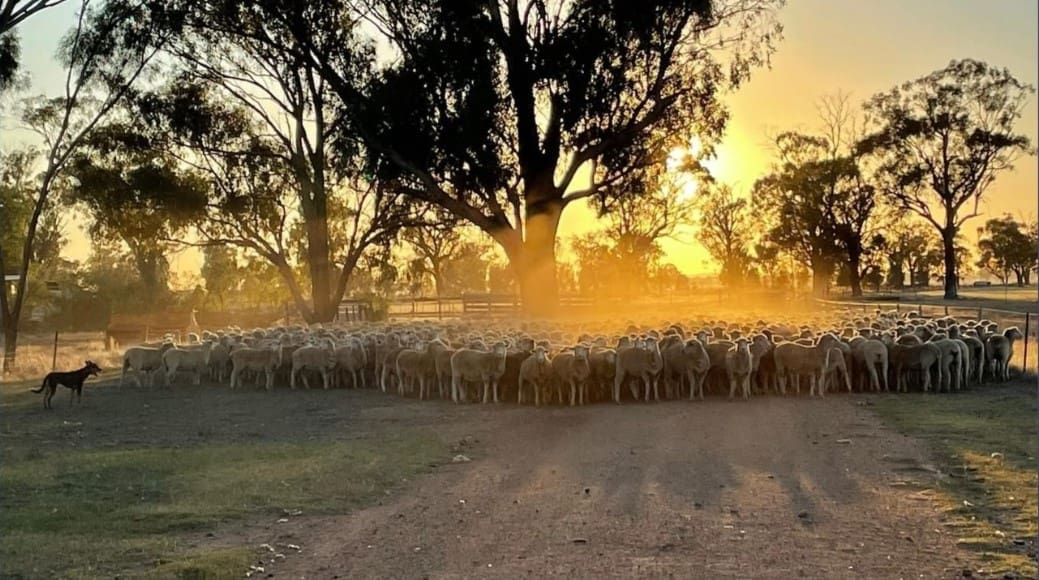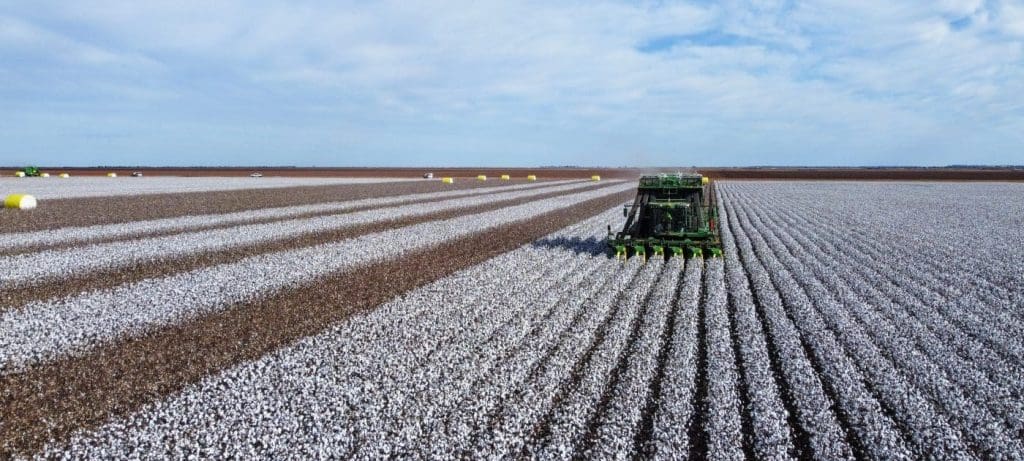
Green Park aggregation near Rand, in the Southern Riverina
BILLIONS of dollars could be spent on Australian farmland as corporates and institutions start competing with Australian farming families this year.
This week, two property industry experts share their thoughts on the remaining six months of 2023 – which LAWD’s Danny Thomas is dubbing the ‘year of the institutions’.

Andrew Garnsey HTW
Herron Todd White’s property valuer for New South Wales and the ACT, Andrew Garnsey, has noted increased activity in the larger scale corporate segment of the market during the past 12 months, with several large transactions occurring in the first half of 2023.
Mr Garnsey said the Green Park Aggregation at Rand in the southern Riverina was an example of a strong sale completed by a corporate farming group which had neighbouring operations.
The 2559ha aggregation comprises four adjoining holdings known as Green Park, Romani, Burnleigh and Karimba and another 309ha parcel known as Moolah located 3.5km to the north-east.
The reported sale price was $39.335 million as well as additional payments for crops underway, plant and equipment.
Mr Garnsey said at $13,715 per hectare for the land and substantial improvements, the sale represented a strong result for arable mixed farming country in that area, superseding per hectare rates paid for much smaller holdings in the past 12 months.

Irrigated Riverina cotton property Gundaline sold to a Chinese company.
Further west, Gundaline Station, one of Australia’s largest irrigated farming operations at Carrathool in the Murrumbidgee Irrigation area of southern New South Wales, transacted for around $120 million.
The 14,924ha irrigation and grazing holding was offered with more than 6000ha of flood irrigation, 12,500 megalitres of groundwater licences, high flow river licences and substantial plant and equipment.
Mr Garnsey said Gundaline was sold to Hong Kong-based Smart Shirts, a clothing manufacturer looking to vertically integrate their production and source cotton from Australia.
“Their clients and end- users (major fashion labels) regard Australia as a suitably safe and ethical producer of fibre compared to many other nations involved in cotton production,” he said.
To the east, Warranoy, a 1644ha mixed farming property at Wallendbeen, was purchased by the neighbouring Caldwell family for $28 million or $17,021/ha.
Mr Garnsey said these sales and others confirmed that larger corporate and family-owned operators are looking for opportunities in this segment of the market.
“They are prepared to pay a premium for scale rather than attempt to organically expand operations over an extended period, particularly in tightly held areas.”
He said corporates and institutions were often prepared to pay a 10 to 20 percent premium for size.
“These opportunities are usually turned over in eight to ten years, so the investors are seeking large turnkey operations (to spread management costs) in the reliable 500mm and above rainfall zones.”
Mr Garnsey said while most corporates and institutions were interested in cropping enterprises, many have indicated a desire to diversify into livestock.
“It is difficult to find ‘cookie cutter’ cropping properties because they are often tightly held. Mixed farms with livestock are now being viewed as an insurance policy in case things don’t go well in the cropping space.”
He said new investment is coming from second-tier funds mandated to hold a portion of their overall investment or pension funds in agriculture.
“Australia is viewed as a safe haven and a secure risk investment because it exports more than it produces.”
‘Year of the institutions’
LAWD senior director Danny Thomas believes the remainder of 2023 will be the ‘year of the institutions’.

Danny Thomas
“Corporate investment has been building, however it didn’t activate until the end of quarter one, when they started completing deals,” Mr Thomas said.
During the ‘perfect storm’ of very low interest rates, extraordinarily high commodity prices and good seasonal conditions, many Australian families and private individuals pushed themselves into the corporate realm, he said.
“Those competing against institutions for larger holdings could outbid them because they had a lower return hurdle – they were investing for multiple generations not for a specific investment time frame.”
Mr Thomas said for the vendor, it was much easier to do a deal with a local group.
“Even if the families couldn’t outbid the corporates on cash, they would beat them on terms, because they weren’t subject to the Foreign Investment Review Board and didn’t have the same due diligence requirements.”
Competitive advantage changes
Mr Thomas said a less favourable outlook was changing the rural property investment environment.
“The cost of debt, lower commodity prices and predictions of a strong El Nino event (after three years of wet La Niña cycles) means many locals have lost their competitive advantage,” he said.
“As a result, it will be more difficult and more expensive for them to access debt as banks demand to know how they can pay the money back in an environment that is not as promising,” he said.
Mr Thomas said these factors would make it difficult for locals to act quickly and beat the corporates.
Currency factor
“Institutions using United States denominated funds (the source of their money is US or North America currency) at US65c to US70c (the current exchange rate) are being given a level of insulation or additional insurance.”
“Even if the currency ‘normalises’ at the US80c mark, institutions will be confident to haggle with more conviction, compared to what they have done in the past,” he said.
Mr Thomas said it was not the exchange rate in isolation that was working in their favour.
“While Australian farmland represents good value, the uncertain environmental factors have given institutions an additional positive lever to go head-to-head and compete with family farm operators.”
He said there was a re-awakening of funds occurring.
“There is fresh or new capital in the institutional sector of several billion dollars that wasn’t in the market last year, coming mainly from North America (United States and Canada).”
Other foreign money
Mr Thomas predicts Japanese insurance money will return to Australia and some old European money is looking at capital preservation and carbon opportunities.
He said the Chinese were back in the market, but it was much more disciplined money and tended to be corporate in origin.
“The initial wave of Chinese money consisted of billionaires looking to get money out of China and into a safe bolthole in another country. Australian agriculture was the excuse,” he said.
Mr Thomas said more sophisticated billionaires followed, genuinely interested in supply chains and their provenance.
“The third wave of Chinese money has become even more sophisticated. Big corporations like Smart Shirts (who purchased Gundaline Station) have a genuine motivation for investing in the supply chain.”
Opportunities
Mr Thomas said in terms of opportunities, scale was key.
“Institutional purchasers who are offered a ‘deal efficiency’ (giving them the end game, rather than having to effect the build-up over time) are happy to pay a premium.”
He said the core areas of interest was row cropping.
“The two principal areas of inquiry are dryland and irrigated – typical winter cropping in any state of Australia or irrigated cotton.”
“The institutional money wants to invest in safe regions such as Moree, Narrabri, Goondiwindi and Dalby,” he said.
Some fresh capital was also looking at livestock operations.
“Previously, many North Americans were allergic to ‘hoofs and heartbeats’ and only wanted cropping places. Today, livestock is an important limb of natural capital investment, and some groups are happy to buy genuine mixed farming opportunities.”
Last month, LAWD sold seven properties for more than $300 million, and all bar one sold to foreign corporates at record levels of value, he said.
Middle East and China returning
Speaking during a Rural Press Club lunch in Brisbane in June, ANZ economist Michael Whitehead said investors from the Middle East and China were travelling back to Australia looking across food supply chains from production to processing and were again making investments.
“We’re also seeing a lot of pension funds around the world saying we see increased positive potential in ag, just because more and more countries are worried about securing food,” he said.
ANZ’s analysis of Foreign Investment Review Board approvals over the past decade highlighted the surge of foreign investment from Canada, America and China.
“There is every likelihood we will see this continue to grow, and there is a reasonable amount being reported arguably in the pipeline or doing due diligence at the moment,” Mr Whitehead said.
“It will be interesting to see the approach of the new Government and the new treasurer through FIRB as to what the attitude will be on this investment back into Australian agriculture.”
